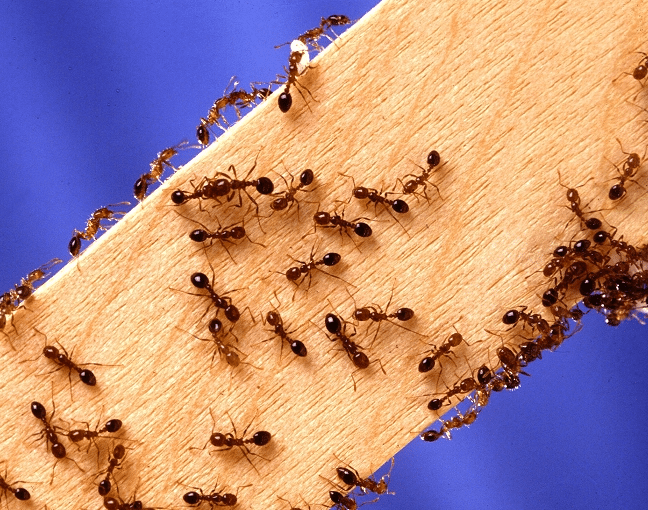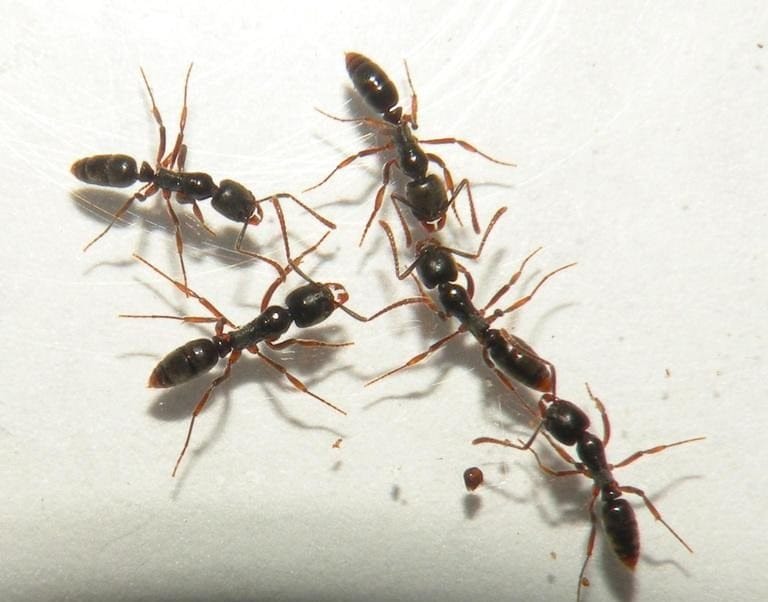See also: Bees/Wasps | Mosquitos
ANTS
Ants may be most notorious for raiding picnics, but when it comes to the remarkably industrious insects, people with allergies have more than their sandwiches and salads to worry about. Some ants carry a fiery sting; others can take a serious bite out of your home; and ant baits can be bad news for those with a peanut problem. So how to keep the persistent pests away from your abode?
For answers on ant safety, we turned to Stoy Hedges, senior technical professional and entomologist with Terminix, as well as the AAAAI’s stinging allergy guidelines.
Fire ants Scott Bauer, USDA Agricultural Research Service, Bugwood.org |
Asian needle ants Jessica Louque, Smithers Viscient, Bugwood.org |
Bug Basics
– People tend to think of ants as little more than pesky picnic raiders, but some ants come with a serious sting, among them the fire ant, the twig ant and the Asian needle ant. Most live in the Southern U.S. and coastal areas such as California and Hawaii.
– Other varieties such as carpenter ants tend to burrow in wood, and if an infestation is serious enough, can seriously damage the structure of a house.
– Most varieties of ants are “nuisance ants” – that is, they don’t sting or destroy wood, but they get into food, damage gardens, etc.
– Ants are extremely diversified, and are some of the most successful creatures on Earth next to man in terms of organization and finding resources to build their tiny cities. Some ants even have multiple cities with little highways of ants going back and forth between them.
– They are also very adaptable, and are constantly looking for better nesting sites and resources.
Did You Know?
– Like most bees and wasps, fire ants and other types of stinging ants can sting more than once.
– Venom from stinging ants such as the fire ant can cause allergic reactions, and in some cases, even life-threatening anaphylaxis.
– There are 70 different species of ants that get into structures around the United States. Roughly 40 of them are somewhat important pests; 10 to 15 can be significant pests, depending on where you live.
– There are 25 varieties of carpenter ants in the U.S. alone; but only four or five types are considered responsible for structural damage to homes and other structures.
– Many ant baits are very effective, even for fire ants, because they take the poison back to the queen and kill the colony; but some colonies have many queens, so this process can take days or even weeks.

Black carpenter ants
DOS
– If you are allergic to any stinging insect, it is strongly recommended that you ask your allergist about venom immunotherapy (commonly known as allergy shots). The treatment significantly reduces the risk of anaphylaxis.
– Keep your yard neat and free of garbage, and regularly prune plants to keep density down.
– Be aware of your surroundings. If you see fire ants or other stinging ants in your yard, take extra precautions.
– Because the pesky ants can sting more than once, if you get stung, remove yourself from the area immediately, and get any ants off.
– There are many different types of ant baits, but different species of ants have different tastes; so if one kind doesn’t work, try another.
– If you have an infestation of stinging ants such as fire ants, you will want to call in the pros – and they may have to come back multiple times.
– If you are showing any signs of an allergic reaction to the sting, seek medical help immediately. You’ll know the reaction is serious if it progresses beyond the site of the sting. If in doubt, get to the hopsital.
DON’TS
– Avoid ground covers and other dense vegetation, especially the types that attract aphids, because ants are attracted to the sticky honeydew the aphids produce.
– Don’t allow fruit trees or other plants to grow too close to the structure of your home, because they attract ants, and you can end up with an infestation.
– Don’t leave any trash around, including any food scraps, and don’t leave pet food outside.
– Don’t leave holes or cracks in the structure of your home, as these are like an open door for ants looking for some new digs.
– Don’t put down more than one to two inches of mulch in your garden, because it can make for great ant habitat.
– Avoid stacking lumber or other wood against the house; at very least raise it off the ground and keep it covered so it remains dry.
– Many ant baits contain peanuts, soy and/or wheat, so read labels carefully and avoid those products if you or someone in your family has a serious allergy.
See also:
Stinging Insect Allergies: Bees/Wasps
Stinging Insect Allergies: Mosquitos





